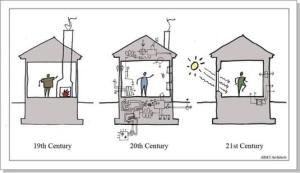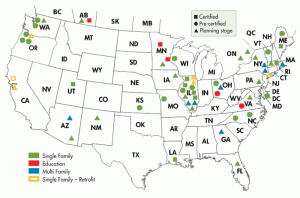Yes, really. You think the oil, coal, natural gas and HVAC companies want you to know about this. NOT. The Passive House movement is in its infancy in the US but it’s already ayoung adult in Europe. It’s called “passive” because heating or cooling these homes relies completely on natural resources. In other words there are no active systems involved in the 90% reduction in energy use! How is this possible I’m sure you want to know. Why didn’t I know about this might be another question.
A passive house uses orientation, super insulation, advanced window technology, air tightness, and shading to achieve standards that are set by the Passiv Haus Institute. These standards eliminate the need for a conventional HVAC system or for solar panels and geothermal systems. Although some homes have an option for solar systems. An energy recovery ventilation system provides a constant, balanced fresh air supply, a uniquely terrific indoor air quality, AND reduces energy use and carbon emissions, according to thePassive House Institute US (PHIUS)
Do passive houses cost more to build? Yep. David Peabody, a Washington metro area architect and passionate promoter of sustainable architecture and passive houses is building a passive house in Bethesda, Maryland. He found that the increased cost for the home he’s building is about 8%. For a 90% reduction in monthly energy bills I’d say it’s worth it. A certified passive house uses less than 1.4 kWh per square foot in heating and cooling energy and uses less than 11kWh per square foot for all energy! By the way, existing homes can be retrofitted to meet many passive home standards.
Barbara Landau and her family are building a second home in Vermont. A Passive House–in Vermont–with no furnace. When several insurance companies asked what kind of heating system the house would have and were told NONE, they declined to insure the house, thinking the pipes would freeze. They won’t. This excellent NY Times articlechronicles their story.
The passive house movement was started when conversations between two German professors at the Institute of Housing and the Environment led to the first passive houses being built in Germany in 1990. To date it is estimated that 15 to 20 thousand passive buildings have been built worldwide, mostly in Germany and Scandinavian countries. The US numbers are far, far fewer. Remember, the movement here is still a nursing baby, but one that is being nurtured by it’s German parent.
This map represents the Passive projects currently underway in the United States today. The squares have been certified, the circles pre-certified and the triangles are in the planning stages. Green represents single family homes, red education, blue multi-family and gold are retrofits.
Buildings use more than 40 percent of all the energy consumed in the United States. If builders were to embrace the passive building concept, both the cost of building and the use of nonrenewable energy sources would decline.
Source:
http://ecogayle.wordpress.com/2011/03/21/passive-houses-use-90-less-energy-no-hvac-system%E2%80%94really/
Source:
http://ecogayle.wordpress.com/2011/03/21/passive-houses-use-90-less-energy-no-hvac-system%E2%80%94really/


Δεν υπάρχουν σχόλια:
Δημοσίευση σχολίου